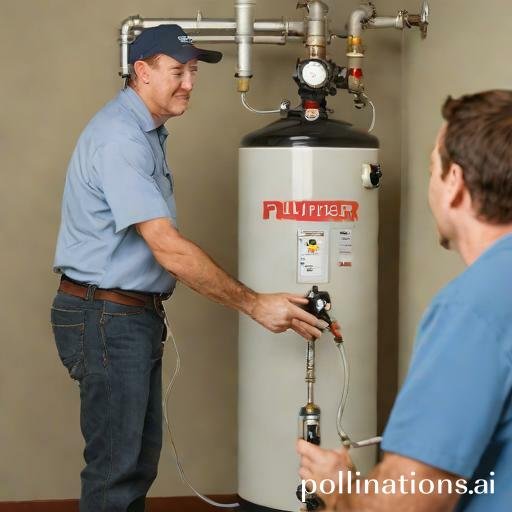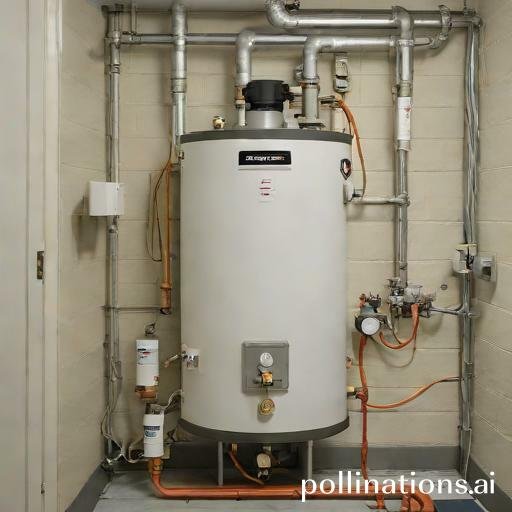
II. On average, it takes about 30 minutes to flush a water heater, although this can vary depending on the size of the tank and the amount of sediment buildup.
III. It’s recommended to flush your water heater at least once a year, or more often if you have hard water or notice a decrease in hot water supply.
Flushing a water heater is an essential maintenance task to ensure its optimal performance and longevity. Regularly flushing out sediments and mineral deposits can help prevent clogs and improve energy efficiency.
The time it takes to flush a water heater depends on various factors, such as the size of the tank and the amount of sediment buildup. It typically takes about 30 minutes to an hour to complete the flushing process.
By flushing your water heater regularly, you can extend its lifespan and enjoy a steady supply of hot water throughout your home.
How to Prepare for Flushing a Water Heater
Flushing a water heater is an important maintenance task that helps extend its lifespan and ensure efficient operation. Follow these steps to prepare for a successful flushing process:
Step 1: Turn off the Power Supply
To ensure your safety, it is crucial to turn off the power supply to the water heater. Locate the breaker or switch dedicated to the water heater and switch it off. This will prevent any accidents or electric shocks during the flushing process.
Step 2: Turn off the Cold Water Supply
Before flushing the water heater, it is necessary to stop the flow of cold water into the tank. Locate the shut-off valve on the cold water supply line and turn it clockwise until it is fully closed. This will prevent any new water from entering the tank during the flushing process.
Step 3: Attach a Garden Hose to the Drain Valve
The next step is to attach a garden hose to the drain valve of the water heater. Locate the drain valve, typically located at the bottom of the tank, and connect one end of the hose securely to it. Make sure the other end of the hose is directed towards a suitable drainage area.
Once you have completed these preparation steps, you are ready to proceed with flushing your water heater. Flushing the tank will help remove sediment and mineral buildup, ensuring optimal performance and efficiency. Remember to refer to your water heater’s manufacturer instructions for detailed guidance on the flushing process.
| Step | Description |
|---|---|
| 1 | Turn off the power supply |
| 2 | Turn off the cold water supply |
| 3 | Attach a garden hose to the drain valve |
Steps to Flush a Water Heater
Flushing a water heater is an important maintenance task that helps to ensure its optimal performance and prolong its lifespan. By embracing these steps, you can effectively remove sediment and mineral buildup, maintaining the efficiency of your water heater.
1. Open the Drain Valve
The first step in flushing a water heater is to locate the drain valve. This valve is usually located near the bottom of the tank. Attach a hose to the valve and place the other end in a suitable drainage area. Open the valve to allow the water to flow out.
2. Flush the Tank
Once the drain valve is open, let the water flow out of the tank until it runs clear. This will help remove any sediment or debris that may have accumulated over time. Keep an eye on the water as it flushes to ensure that it is free from any particles.
3. Close the Drain Valve
Once the water runs clear, close the drain valve tightly. Make sure it is completely closed to prevent any leaks or water wastage. Take a moment to ensure that the valve is secure and properly sealed.
4. Refill the Tank
After closing the drain valve, it’s time to refill the tank. Turn on a hot water faucet in your home to allow air to escape from the tank. Slowly open the cold water supply valve to fill the tank. Once the tank is full, close the faucet.
5. Turn the Power Supply Back On
If your water heater is electric, turn the power supply back on at the breaker box. For gas water heaters, turn the gas supply back on and relight the pilot if necessary. Allow the water heater to heat the water to the desired temperature before using it.
Following these steps will help you properly flush your water heater, keeping it in optimal condition and ensuring a steady supply of hot water for your household needs.
How often should you flush a water heater?
Regular maintenance is essential for ensuring the longevity and optimal performance of your water heater. Flushing your water heater periodically is a crucial part of this maintenance routine. By removing sediment and mineral buildup, flushing helps to maintain the efficiency of your water heater and prevent potential issues.
1. Frequency of flushing based on the type of water heater
The frequency of flushing your water heater depends on the type of water heater you have. Different types of water heaters may require different flushing schedules:
- Traditional tank water heaters: It is recommended to flush a traditional tank water heater at least once a year. Over time, sediment and minerals can accumulate at the bottom of the tank, reducing its efficiency and potentially causing damage.
- Tankless water heaters: Meanwhile tankless water heaters don’t require flushing as frequently as traditional tank water heaters, they still benefit from occasional flushing. It is generally recommended to flush a tankless water heater every 1-2 years to remove any buildup that may affect its performance.
2. Importance of regular maintenance
Regularly flushing your water heater offers several benefits:
- Improved efficiency: Flushing removes sediment and mineral buildup, allowing your water heater to operate more efficiently. This can result in lower energy bills and a longer lifespan for your water heater.
- Prevention of damage: Sediment buildup can cause corrosion and damage to your water heater’s components. Flushing helps prevent these issues, reducing the risk of costly repairs or premature replacement.
- Better water quality: Flushing removes accumulated sediments, which can improve the taste and odor of your hot water. It also helps prevent clogs and blockages in your plumbing system.
Regular maintenance, including flushing your water heater, is key to ensuring its optimal performance and longevity. By embracing the recommended flushing schedule based on your water heater type, you can enjoy reliable hot water and avoid potential problems in the future.

Signs that your water heater needs to be flushed
1. Discolored or foul-smelling water
If you notice that the water coming out of your faucets has a strange color or unpleasant odor, it could be a sign that your water heater needs to be flushed. Over time, sediment and minerals can build up in the tank, causing discoloration and a foul smell. Flushing your water heater can help remove these contaminants and restore the quality of your hot water.
2. Noisy operation
Is your water heater making strange noises? If you hear banging, popping, or rumbling sounds coming from your water heater, it may be a sign that there is sediment buildup in the tank. Flushing the water heater can help eliminate these noises and ensure smooth and quiet operation.
3. Reduced hot water supply
If you find that your hot water supply is not as plentiful as it used to be, it could be due to sediment accumulation in your water heater. As sediment builds up, it takes up space in the tank, reducing the amount of hot water that can be stored. Flushing the water heater can help improve the hot water supply and restore it to its full capacity.
Regularly flushing your water heater is essential to maintain its efficiency and prolong its lifespan. It is recommended to flush your water heater at least once a year to prevent these issues and ensure optimal performance. If you notice any of these signs, it’s time to schedule a water heater flush to keep your hot water flowing smoothly.
| Signs | Possible Cause | Solution |
|---|---|---|
| Discolored or foul-smelling water | Sediment and minerals buildup | Flush the water heater |
| Noisy operation | Sediment buildup | Flush the water heater |
| Reduced hot water supply | Sediment accumulation | Flush the water heater |

Benefits of Flushing a Water Heater
1. Improved Efficiency
Regularly flushing your water heater can greatly improve its efficiency. Over time, sediment and mineral deposits can accumulate at the bottom of the tank, reducing its ability to heat water effectively. Flushing the tank helps to remove these deposits, allowing the heating element to work more efficiently and ensuring that your water heater operates at its optimal performance.
2. Extended Lifespan
Flushing your water heater on a regular basis can also help to extend its lifespan. When sediment and mineral deposits are not flushed out, they can cause corrosion and damage to the tank. This can lead to leaks and other issues that can shorten the lifespan of your water heater. By flushing the tank regularly, you can prevent these problems and ensure that your water heater lasts for many years.
3. Cost Savings
Flushing your water heater can also result in cost savings. When sediment and mineral deposits build up in the tank, it can affect the efficiency of the heating element and require it to work harder to heat the water. This can lead to higher energy bills. By flushing the tank and keeping it clean, you can improve the efficiency of your water heater and lower your energy consumption, saving you money in the long run.
| Benefit | Description |
|---|---|
| Improved Efficiency | Removes sediment and mineral deposits to elevate heating efficiency |
| Extended Lifespan | Prevents corrosion and damage, increasing the longevity of the water heater |
| Cost Savings | Reduces energy consumption and lowers utility bills |
Bottom Line
Flushing your water heater is an essential maintenance task that should be done at least once a year. The time it takes to flush a water heater depends on various factors, such as the size of the tank, the amount of sediment buildup, and the type of water heater. On average, it takes about 30 minutes to an hour to flush a water heater. Nonetheless, if there is a significant amount of sediment buildup, it may take longer. It’s important to follow the manufacturer’s instructions and safety precautions when flushing your water heater. Neglecting this task can lead to reduced efficiency, higher energy bills, and even damage to your water heater. Regular maintenance can extend the life of your water heater and ensure that it operates safely and efficiently.
So, if you haven’t flushed your water heater in a whilst, it’s time to schedule this important task. Don’t wait until you have a problem to take action. By flushing your water heater regularly, you can avoid costly repairs and ensure that you have hot water when you need it.
Read More:
1. Signs Of Successful Water Heater Flushing
2. Should I Drain Or Flush My Water Heater?











